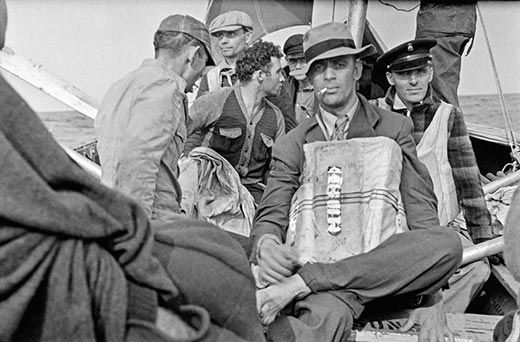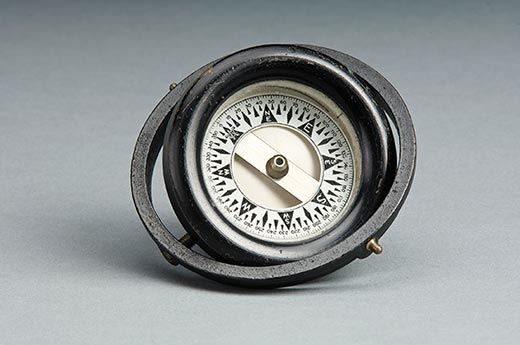A Compass Saves the Crew
A WWII sailor’s memento recalls the harrowing ordeal when his ship, the SS Alcoa Guide, was struck by a German U-Boat
/https://tf-cmsv2-smithsonianmag-media.s3.amazonaws.com/filer/Waldemar-Semenov-compass-631.jpg)
A small, seemingly unprepossessing device—a compass four and a half inches in diameter—testifies to a story of war and remembrance, resolve and survival. The artifact is one among scores showcased in a major permanent exhibition at the National Museum of American History, "On the Water: Stories from Maritime America," which opened this past May.
Retired merchant seaman Waldemar Semenov, 95, donated the compass in 2005. In 1942, Semenov, a Russian immigrant, was serving as a junior engineer on the American merchant ship SS Alcoa Guide, sailing from New Jersey to the Caribbean island of Guadeloupe with a cargo of supplies and equipment for the West Indies. On the night of April 16, about 300 miles east of Cape Hatteras, North Carolina, a German submarine, the U-123, surfaced and opened fire with its deck cannon. "We didn't have any guns, and there was no escort," Semenov recalls. "We didn't have much speed. They used us as target practice."
In the first six months of 1942, German submarines sank 400 ships in the Atlantic. At the time, my family was living in a house on the New Jersey shore. I was only 4, but I vividly recall my father waking my older brother and me in the middle of the night, wrapping us in blankets and taking us down to the beach. He pointed to flickering lights on the horizon. "Remember this," he said. "Those are the flames of ships torpedoed by the Germans."
The Alcoa Guide was unarmed, but its captain, Samuel Cobb, tried to ram the sub; he was easily outmaneuvered. Before long, Cobb was wounded, the ship was on fire and beginning to sink, and the crew was scrambling on deck to lower two lifeboats and a raft into the water.
Semenov says he stayed calm; this was not his first exposure to combat. "I had been in Spain during the civil war," he says. In waters off England, he adds, "the ship next to us had been hit by German planes, so I'd seen bombing and shooting before. I wanted to size up the situation."
Semenov returned to his cabin and put on a new suit and an overcoat, even taking some time to decide between two neckties. A photograph taken later in a lifeboat attests to his account—Semenov's fedora looks the worse for a night of rain, but his suit and carefully knotted tie are surprisingly presentable. By then Semenov had given his overcoat to a crew member who had rushed on deck in his underwear.
Before getting in a lifeboat, Semenov also had gone to the galley and snatched up three loaves of bread. "I knew we might be in the lifeboats for a while," he says, "and the rations in the boats wouldn't be enough."
As the burning ship sank lower in the water and the lifeboats and raft pulled away, the crew could see the submarine illuminated by flames, its deck gun now silent. "They didn't fire at the lifeboats," Semenov recalls. "In those days, everyone played by the rules."
Using the small compass on the lifeboat, the survivors sailed west by northwest toward the shipping lanes. After three days, a patrol plane, searching for sailors from any of the half-dozen ships sunk that week, spotted Semenov's lifeboat. The next day, after a night of heavy rain, the American destroyer USS Broome rescued the men and soon picked up the other lifeboat and its survivors. (The raft was found three weeks after the sinking, with only one man still alive. Captain Cobb had died in the other lifeboat and was buried at sea, along with a crew member who had been killed in the shelling.) In all, 27 Alcoa Guide crew members survived; seven perished.
During preparations for the NMAH exhibition, about U.S. shipbuilding efforts during the world wars, curator Paula Johnson heard about Semenov's wartime experiences while touring the Marine Engineers Beneficial Association at the Calhoon Engineering School near Easton, Maryland. She visited Semenov at his home on Long Island in New York. "He told me his remarkable story; when I asked if the museum could have the compass, he immediately said yes."
Not long after his return to port, Semenov enlisted in the Army and served as an engineer on troopships and supply ships with both the Army and Navy in the Atlantic and Pacific. He continued to serve in the military and as a merchant seaman until 1987. Semenov's nemesis, the U-123, was intentionally scuttled by the Germans off the coast of France in 1944, but was salvaged by the French Navy. Re-christened the Blaison, the sub remained in service until 1959.
Owen Edwards is a freelance writer and author of the book Elegant Solutions.
/https://tf-cmsv2-smithsonianmag-media.s3.amazonaws.com/accounts/headshot/Owen-Edwards-240.jpg)


/https://tf-cmsv2-smithsonianmag-media.s3.amazonaws.com/accounts/headshot/Owen-Edwards-240.jpg)